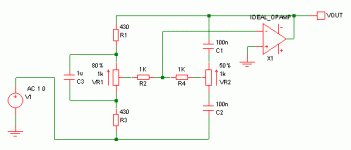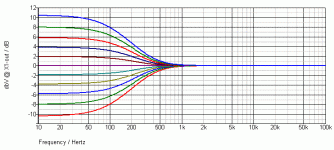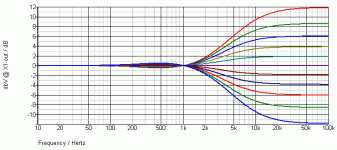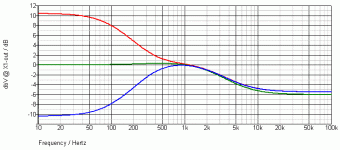Please explain , the article said the tone controls provided boost at 100 hz and 10 kHz .
What is there to understand , what's missing ......?
Hi,
The tone control specification is ±8 dB (100 Hz) and ±8.5 dB (10 kHz).
They look like a typical Baxandall centred on 800Hz.
rgds, sreten.
Different circuit, centred a bit lower, ±10dB @ 50Hz and 10KHz :
An externally hosted image should be here but it was not working when we last tested it.
Last edited:
Do the boost and cut curves return to unity outside of the audio band... must get a copy of this to see what it's all about 
On the subject of noise that ThorstenL mentions (and the 5532).
Doug seems to take each design as a challenge (and rightly so) in obtaining the best performance possible and in pushing the boundaries ever further toward measured perfection. Whether that results in the best audible performance can be (and is) debated ad-infinitum. I think we have to accept we all like and seek different ideals and what works for one doesn't for another. Noise is never an issue to me subjectively. Older recordings have tape hiss... in some ways that can add a certain "patina" to sound. There is a thought too that it helps the ear winkle out fine low level detail a bit like dithering a digital signal.
The 5532... I can never make my mind up on that. In some applications it is inferior to other devices but that may be a matter of the initial design rather than a failing of the device itself. I am thinking particularly of I/V conversion where I find it less than ideal although many manufacturers use it.
Just as an off topic, it's interesting to compare some of the big names who are on this forum.... and these are just my personal feelings and are to be taken as such.
Doug... is the model of doing it by the book and seeking technical perfection. His technical knowledge is awsome but I always feel that listening tests come way down the priorities, at least that is how much of his work comes across. Why would you want or need to listen when the performance is this good.
Bob Cordell... who really understands the whole audio subject and has done some ground breaking work in pushing toward perfection is someone who actually hints and acknowledges that some things and some ways of doing things may not always be the best sonically. Certainly seems open to knowing that listening as well as numbers are just as important in the final design.
Hugh Dean- AKSA- probably understands more than most that all this is about recreating a musical experience and that you can work with and manipulate distortions to give the WOW factor when listening to reproduced music. And that to me is what it's all about.
Nelson Pass... Class A and FET guru. I think it's fair to say that sonics play a big part in Nelsons design methodology.
John Curl... perhaps the wildcard in all this Huge ability and understanding in how it all comes together.
Huge ability and understanding in how it all comes together.
On the subject of noise that ThorstenL mentions (and the 5532).
Doug seems to take each design as a challenge (and rightly so) in obtaining the best performance possible and in pushing the boundaries ever further toward measured perfection. Whether that results in the best audible performance can be (and is) debated ad-infinitum. I think we have to accept we all like and seek different ideals and what works for one doesn't for another. Noise is never an issue to me subjectively. Older recordings have tape hiss... in some ways that can add a certain "patina" to sound. There is a thought too that it helps the ear winkle out fine low level detail a bit like dithering a digital signal.
The 5532... I can never make my mind up on that. In some applications it is inferior to other devices but that may be a matter of the initial design rather than a failing of the device itself. I am thinking particularly of I/V conversion where I find it less than ideal although many manufacturers use it.
Just as an off topic, it's interesting to compare some of the big names who are on this forum.... and these are just my personal feelings and are to be taken as such.
Doug... is the model of doing it by the book and seeking technical perfection. His technical knowledge is awsome but I always feel that listening tests come way down the priorities, at least that is how much of his work comes across. Why would you want or need to listen when the performance is this good.
Bob Cordell... who really understands the whole audio subject and has done some ground breaking work in pushing toward perfection is someone who actually hints and acknowledges that some things and some ways of doing things may not always be the best sonically. Certainly seems open to knowing that listening as well as numbers are just as important in the final design.
Hugh Dean- AKSA- probably understands more than most that all this is about recreating a musical experience and that you can work with and manipulate distortions to give the WOW factor when listening to reproduced music. And that to me is what it's all about.
Nelson Pass... Class A and FET guru. I think it's fair to say that sonics play a big part in Nelsons design methodology.
John Curl... perhaps the wildcard in all this
Nope, it's pretty boring, simple boost and cut above and below 1KHz. The treble control is one of those that cuts the midrange when boosting the treble (and vice versa), and turning the bass control to either extreme reduces the effectiveness of the treble control, but both effects are small (less than 1dB).Do the boost and cut curves return to unity outside of the audio band...
I was amused to see him getting the treble control null spot on 1KHz, using bog standard values.
The circuit I used is slightly simplified. The feedback network is identical. I just left out the opamp overkill, assumed everything is driven from zero source impedance and ignored pot wiper resistance, so there are probably slight errors, but nothing to get excited about.
Attachments
For sure that is a paradigm shift. Given the on-line individual end user reviews of today, performance now has a voice, but brand, advertising, prices and packages are seen as lies for appliances and electronics in general. Imagine attempting to shop for headphones at a major electronics store, but encounter only sealed packages. What happens is that you go home empty handed and research performance reviews on-line.Daniel,
Do you really expect any correlation between circuitry, measurement data and market success?
jan
The proposed process would work identically to sorting out an overlarge music collection, except that we're actually talking about data on Doug Self designs and derivatives, so the bets are nicely hedged towards good performance.
I didn't say it would be an easy thing to do. It is more like trying to find which haybale has the cell phone inside after the phone had been dropped in a mowed hay meadow earlier that day. OH, don't ask.
Is this the circuit for 50hz, 12khz? Or is it the 100hz, 10khz?The circuit I used is slightly simplified. The feedback network is identical. I just left out the opamp overkill, assumed everything is driven from zero source impedance and ignored pot wiper resistance, so there are probably slight errors, but nothing to get excited about.
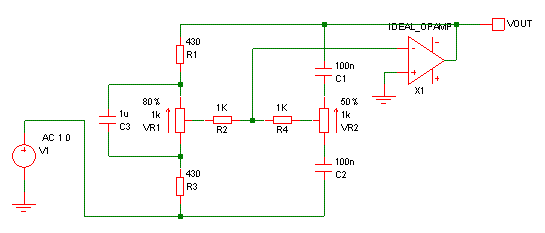
Last edited:
Hi,
And that needs HOW MANY Op-Amp's? (answers on a postcard).
I would suggest for anyone interested in tone controls, active line stage and simple circuits with high quality parts and no need for any more than one good OPA and one (optional) simple discrete buffer may wish to look here (see earlier posts for the single transistor plus LM317 Buffer):
http://www.diyaudio.com/forums/analog-line-level/194119-high-end-tone-control.html#post2688984
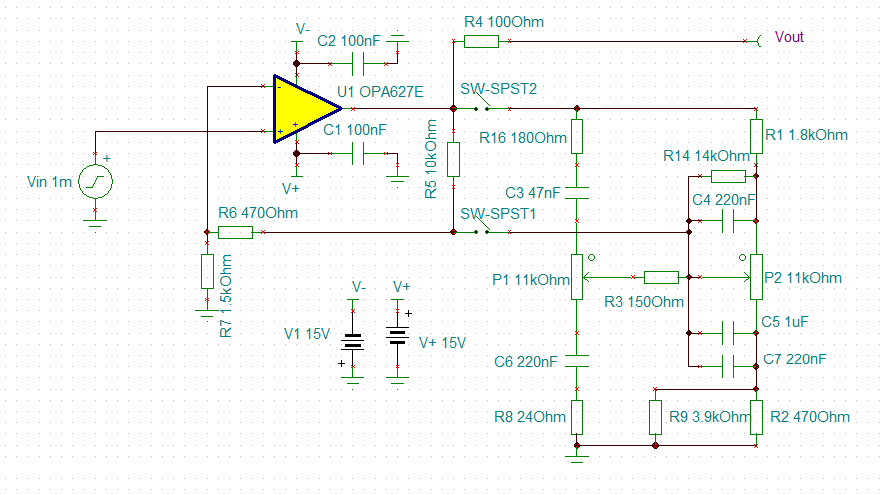
This circuit can be fed by any volume control we care to use, however a 10K control should be considered if the circuits noise is not to be increased unduly. The tonecontrol has a fully transparent bypass option and can in principle have selectable corner frequencies (not shown)
As shown the linestage has around 16dB gain and -100dBU unweighed output SNR, worst case, 10K volume control.
When driving a 600 ohm Load to +19dBU the UNBUFFERED linestage will produce 0.003% THD(20K) and 0.0002% THD(1k). Adding a suitable buffer can extend this performance to lower impedance loads and can reduce the THD for 600 Ohm loads.
Without the addition of any RC Filters the -3dB Bandwidth will be DC to 2MHz.
(all numbers based on OPA627 Datasheet and Johnson noise of the circuit impedances)
To put the noise into perspective, if 0dBU is set to -8dBmax on the poweramp input (say a 200W/8R amplifier with 2V rated input) and the Amp and Speaker can deliver 114dB SPL at the listening position for +8dBU input (that would need a speaker with 88dB/2.83V/1m sensitivity and 0dB compression at 200W continous input), the noise contributed by this linestage will be below the hearing threshold at all frequencies.
For more SPL noise may just cross the hearing threshold, for lower maximum SPL (inefficient speaker) noise will more below the hearing threshold. I am sure the above levels of noise and distortion can be beaten by D. Self design (or actually not, given the post on page 1 - I'm disappointed).
However if any better measured performance than this would be necessary or beneficial I have yet to see any evidence or proof thereof.
Ciao T
Hi,
The tone control specification is ±8 dB (100 Hz) and ±8.5 dB (10 kHz).
They look like a typical Baxandall centred on 800Hz.
And that needs HOW MANY Op-Amp's? (answers on a postcard).
I would suggest for anyone interested in tone controls, active line stage and simple circuits with high quality parts and no need for any more than one good OPA and one (optional) simple discrete buffer may wish to look here (see earlier posts for the single transistor plus LM317 Buffer):
http://www.diyaudio.com/forums/analog-line-level/194119-high-end-tone-control.html#post2688984

This circuit can be fed by any volume control we care to use, however a 10K control should be considered if the circuits noise is not to be increased unduly. The tonecontrol has a fully transparent bypass option and can in principle have selectable corner frequencies (not shown)
As shown the linestage has around 16dB gain and -100dBU unweighed output SNR, worst case, 10K volume control.
When driving a 600 ohm Load to +19dBU the UNBUFFERED linestage will produce 0.003% THD(20K) and 0.0002% THD(1k). Adding a suitable buffer can extend this performance to lower impedance loads and can reduce the THD for 600 Ohm loads.
Without the addition of any RC Filters the -3dB Bandwidth will be DC to 2MHz.
(all numbers based on OPA627 Datasheet and Johnson noise of the circuit impedances)
To put the noise into perspective, if 0dBU is set to -8dBmax on the poweramp input (say a 200W/8R amplifier with 2V rated input) and the Amp and Speaker can deliver 114dB SPL at the listening position for +8dBU input (that would need a speaker with 88dB/2.83V/1m sensitivity and 0dB compression at 200W continous input), the noise contributed by this linestage will be below the hearing threshold at all frequencies.
For more SPL noise may just cross the hearing threshold, for lower maximum SPL (inefficient speaker) noise will more below the hearing threshold. I am sure the above levels of noise and distortion can be beaten by D. Self design (or actually not, given the post on page 1 - I'm disappointed).
However if any better measured performance than this would be necessary or beneficial I have yet to see any evidence or proof thereof.
Ciao T
The shape of the curves, what happens with partial boost or cut, interaction between the controls. Different versions of the Baxandall controls actually behave quite differently.
I'll do some sims now to get an idea, and post the results when I'm done.
Hi,
The tone control specification is ±8 dB (100 Hz) and ±8.5 dB (10 kHz).
They look like a typical Baxandall centred on 800Hz.
rgds, sreten.
Different circuit, centred a bit lower, ±10dB @ 50Hz and 10KHz :
An externally hosted image should be here but it was not working when we last tested it.
Nope, it's pretty boring, simple boost and cut above and below 1KHz. The treble control is one of those that cuts the midrange when boosting the treble (and vice versa), and turning the bass control to either extreme reduces the effectiveness of the treble control, but both effects are small (less than 1dB).
I was amused to see him getting the treble control null spot on 1KHz, using bog standard values.
The circuit I used is slightly simplified. The feedback network is identical. I just left out the opamp overkill, assumed everything is driven from zero source impedance and ignored pot wiper resistance, so there are probably slight errors, but nothing to get excited about.
So the values given were not of the center frequency and after seeing this, it's worst than I thought....Why ?
I guess the bypass relays will get full use ...........
Those are the values that Doug Self used.Is this the circuit for 50hz, 12khz? Or is it the 100hz, 10khz?
Nope, it's pretty boring, simple boost and cut above and below 1KHz.
Thanks godfrey
I tried to find a copy today but could only find the March issue. April not on sale until 22nd in UK/Europe according to small print in mag.
So from what I am reading here Doug must have had a rethink on not limiting the boost outside of the audio band.
Hi,
And that needs HOW MANY Op-Amp's? (answers on a postcard).
I would suggest for anyone interested in tone controls, active line stage
.
.
.

This circuit can be fed by any volume control we care to use, however a 10K control should be considered if the circuits noise is not to be increased unduly.
.
.
.
For more SPL noise may just cross the hearing threshold, for lower maximum SPL (inefficient speaker) noise better measured performance than this would be necessary or beneficial I have yet to see any evidence or proof thereof.
Ciao T
The OPA627 cannot drive heavy loads at higher audio frequencies without some serious distortion. If suitably buffered, it is a good chip, but at $10 a pop it's expensive. Read the data sheet and stick to the facts. So, where did you get you numbers from? Please show the measurement data.
Bottom line is Doug Self is a hugely respected audio designer who has published some very successful books. And, he is he guy that swept all the b.s. around audio out of the door when his audio power amp design book was published in 1996. The other guy that needs to be recognized here is Robert Cordell. And, both have published papers as well. That's a lot more than can be said for for some of the people on this forum who tout themselves as experts - and I am talking about people in the industry, not the DIYers.
I would not fret about he Baxandall curves and the cut and boost levels. They are easy to adjust and in my early twenties I built many. I agree with some of he comments here that +- 20dB is way too much for a normal system. I think +-10dB is more like it at the frequency extremes. This is where LT Sice shines by the way for tweaking the overall transfer function.
And a good bypass relay or switch is a must.
And a good bypass relay or switch is a must.
Last edited:
If you want continuously variable control, not so much no. Presets, perhaps.
@Bonsai: And, he is he guy that swept all the b.s. around audio out of the door when his audio power amp design book was published in 1996. Do please give us a break from hagiographies
@Bonsai: And, he is he guy that swept all the b.s. around audio out of the door when his audio power amp design book was published in 1996. Do please give us a break from hagiographies
Last edited:
Hi,
Your evidence is based on what?
The datasheet shows 7V/20KHz @ 20dB gain into 600 Ohm at 0.05% THD.
So clearly I CAN read the datasheet.
But you only need ONE and generally at normal line levels and impedances the buffering is optional.
The Burr Brown datasheet for the OPA627.
He is generally not very respected who have to rectify the grounding design faults in his mixing desks.
And?
So has "The Rock"...
Really. His focus solely on THD when THD is meaningless is as much b.s., a strictly faith-based approach not funded in reality...
The work DS has done is extensive and has some uses, but overall it is by far to myopic and prejudiced to be of much use.
Robert I give a lot more respect than DS, at least he how to get the grounding right and knows to look over the rim of his plate. In fact, I respect him most for seriously investigating any number of areas raised by the "subjectivsists" all the way to zero feedback Amplifiers...
I have considered the money for Roberts Book well spend. On the other hand I got way better value out of Samuel Groners criticism of D. Delf's Book than out of the book.
And?
Ciao T
The OPA627 cannot drive heavy loads at higher audio frequencies without some serious distortion.
Your evidence is based on what?
Read the data sheet and stick to the facts.
The datasheet shows 7V/20KHz @ 20dB gain into 600 Ohm at 0.05% THD.
So clearly I CAN read the datasheet.
If suitably buffered, it is a good chip, but at $10 a pop it's expensive.
But you only need ONE and generally at normal line levels and impedances the buffering is optional.
So, where did you get you numbers from?
The Burr Brown datasheet for the OPA627.
Bottom line is Doug Self is a hugely respected audio designer
He is generally not very respected who have to rectify the grounding design faults in his mixing desks.
Bottom line is Doug Self ... has published some very successful books.
And?
So has "The Rock"...
And, he is he guy that swept all the b.s. around audio out of the door when his audio power amp design book was published in 1996.
Really. His focus solely on THD when THD is meaningless is as much b.s., a strictly faith-based approach not funded in reality...
The work DS has done is extensive and has some uses, but overall it is by far to myopic and prejudiced to be of much use.
The other guy that needs to be recognized here is Robert Cordell.
Robert I give a lot more respect than DS, at least he how to get the grounding right and knows to look over the rim of his plate. In fact, I respect him most for seriously investigating any number of areas raised by the "subjectivsists" all the way to zero feedback Amplifiers...
I have considered the money for Roberts Book well spend. On the other hand I got way better value out of Samuel Groners criticism of D. Delf's Book than out of the book.
And, both have published papers as well.
And?
Ciao T
Hi,
Your evidence is based on what?
The datasheet shows 7V/20KHz @ 20dB gain into 600 Ohm at 0.05% THD.
So clearly I CAN read the datasheet.
But you only need ONE and generally at normal line levels and impedances the buffering is optional.
The Burr Brown datasheet for the OPA627.
He is generally not very respected who have to rectify the grounding design faults in his mixing desks.
And?
So has "The Rock"...
Really. His focus solely on THD when THD is meaningless is as much b.s., a strictly faith-based approach not funded in reality...
The work DS has done is extensive and has some uses, but overall it is by far to myopic and prejudiced to be of much use.
Robert I give a lot more respect than DS, at least he how to get the grounding right and knows to look over the rim of his plate. In fact, I respect him most for seriously investigating any number of areas raised by the "subjectivsists" all the way to zero feedback Amplifiers...
I have considered the money for Roberts Book well spend. On the other hand I got way better value out of Samuel Groners criticism of D. Delf's Book than out of the book.
And?
Ciao T
Very well put. I was scratching my head at the OPA627 comments as I have used this unbuffered in my own linestages. I would add:
What does this design offer that I can't find in any early to mid '80s mass produced mid-fi?
Tone controls aka filters and multiple gain stages and maybe even a few electrolytics in the signal path.
Isn't this the antithesis of what modern high quality, "high end" audio design and diy'ing strives for?
As for audio designers selling books, there seems to be an inverse relationship at work there between books and audio products.
Torsten, show us the distortion graph for the circuit you posted earlier. Before dong that, take a look a Samuel Groners site and read up on the device.
0.05% at 20kHz 7V is high and completely avoidable. That's 500ppm.
The OPA6x7 is quiet and the bias currents are low, but it does not drive loads very well.
What is the load current on the devices output at HF when your tone control is set to the worst case position (wrt load current)? Have you simmed or measured your circuit?
0.05% at 20kHz 7V is high and completely avoidable. That's 500ppm.
The OPA6x7 is quiet and the bias currents are low, but it does not drive loads very well.
What is the load current on the devices output at HF when your tone control is set to the worst case position (wrt load current)? Have you simmed or measured your circuit?
Last edited:
Hi
First, the circuit is a concept, which I made clear in the original thread. The performance of the OPA627 in this circuit is easily predicted from the datasheet and circuit by anyone "skilled in the electronic arts".
You can read circuits, right? The effective load at 20KHz is 530 Ohm and the minimum HF load is 450 Ohm.
It is high compared to what? What is your reference?
And what is your evidence that 0.05% THD at 20KHz, with the tone control fully up is a problem?
Without concrete referen ce you merely expressing a belief not grounded in any evidence.
What is Self Preamp's THD at 7V RMS, 20KHz treble controls at full boost?
No, I have not dimmed the circuit. I do not have a dimmer on my Laptop.
It has been simulated in Tina-Ti. I have measured OPA627 based circuits and know it performs like shown in the datasheet if applied competently.
Ciao T
Torsten, show us the distortion graph for the circuit you posted earlier. Before dong that, take a look a Samuel Groners site and read up on the device.
First, the circuit is a concept, which I made clear in the original thread. The performance of the OPA627 in this circuit is easily predicted from the datasheet and circuit by anyone "skilled in the electronic arts".
What is the load current on the devices output at HF when your tone control is set to the worst case position (wrt load current)
You can read circuits, right? The effective load at 20KHz is 530 Ohm and the minimum HF load is 450 Ohm.
0.05% at 20kHz 7V is high and completely avoidable. That's 500ppm.
It is high compared to what? What is your reference?
And what is your evidence that 0.05% THD at 20KHz, with the tone control fully up is a problem?
Without concrete referen ce you merely expressing a belief not grounded in any evidence.
What is Self Preamp's THD at 7V RMS, 20KHz treble controls at full boost?
Have you dimmed or measured your circuit?
No, I have not dimmed the circuit. I do not have a dimmer on my Laptop.
It has been simulated in Tina-Ti. I have measured OPA627 based circuits and know it performs like shown in the datasheet if applied competently.
Ciao T
- Home
- Source & Line
- Analog Line Level
- New Doug Self pre-amp design...
